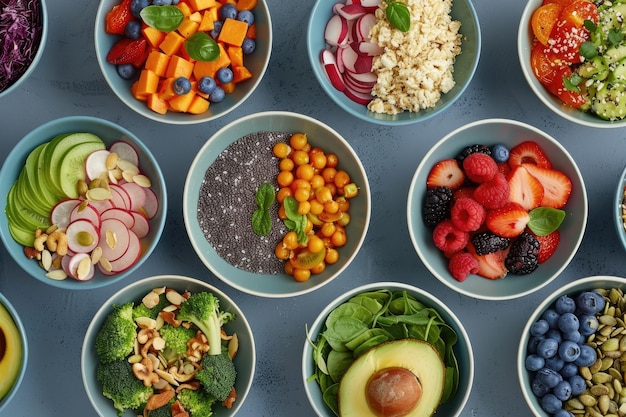In the fight against non-communicable diseases, increasing the intake of vegetables and fruits (V&F) is recognized as a crucial preventive measure. However, encouraging adolescents to modify their eating habits poses unique challenges. To address this, researchers led by Machteld van Lieshout embarked on an innovative project titled “Development of the Food Boost Challenge: A Participatory Action Research Approach to Enhance Vegetable and Fruit Consumption among Adolescents.” This study explores a dynamic participatory action research method that actively involves adolescents in the process of enhancing their V&F consumption.
The research unfolded through the Food Boost Challenge (FBC), a collaborative initiative that engages adolescents, peer researchers, and various partners from non-governmental and commercial sectors. Launched between 2021 and 2022, the FBC saw contributions from 34 partners who provided support through both financial and non-financial means. The project was divided into multiple phases, beginning with pre-vocational students identifying barriers and drivers of V&F consumption among their peers. Subsequent phases involved generating innovative ideas, developing prototypes, and providing a national platform for these concepts.
The findings of this research indicate that the FBC was successful in resonating with all stakeholders and generated actionable insights and prototypes that could lead to increased V&F intake. This model holds promise not only for encouraging healthier eating habits among adolescents but also for broader applicability in promoting various health behaviors among school-aged children.
The urgency of addressing non-communicable diseases (NCDs) stands as a monumental global health challenge. Foremost among the shifts needed to curb the rise of these diseases is the alteration of dietary habits—particularly, the augmented consumption of vegetables and fruits (V&F). NCDs such as cardiovascular diseases, diabetes, and certain forms of cancer are profoundly linked with poor diet and could be significantly reduced through preventive dietary measures. Despite the clear evidence supporting dietary improvements as a key factor in preventing NCDs, global consumption levels of V&F remain alarmingly low, especially among adolescents.
Adolescence—a critical period marked by significant physical, emotional, and psychological changes—is also a phase where lifelong eating habits are formed. However, it is simultaneously a stage characterized by increased independence and rebellion against advisories, making dietary interventions particularly challenging. The traditional methods of improving V&F intake, such as direct education and behavior modification programs, have often fallen short in this demographic. The inertia in changing these habits is compounded by both external and internal factors including peer influences, familial eating patterns, advertising, and the availability of foods within homes and schools.
Recognizing these challenges, the innovative approach taken in the Development of the Food Boost Challenge employs Participatory Action Research (PAR), which stipulates collaboration with the target demographic—as active participants rather than mere subjects—to uncover and enact solutions. By involving adolescents directly in the research process, this approach seeks to empower them and enhance their engagement and commitment to changing their own eating habits.
The initiation of the Food Boost Challenge (FBC) by Machteld van Lieshout and her team is part of a broader strategic response to this need. Positioned at the intersection of academia, public health policy, and community engagement, the project builds on the premise that effective change in food behavior among adolescents requires not just knowledge dissemination, but active, context-sensitive involvement that taps into adolescents’ own creative and social resources.
This initiative is grounded in earlier research which underscores that participatory and inclusive strategies can yield more sustainable behavior change. Moreover, the variegated partnerships spanning non-governmental organizations, academia, and the commercial sector underscore a multi-sectoral approach that extends the potential reach and impact of the interventions devised through the FBC.
In deploying the FBC, the project did not merely aim to propose new consumption solutions but to foster a milieu where adolescents feel genuinely involved in the process. This engagement is hypothesized to transform their roles from passive recipients of health information to champions of their health destinies. Such a paradigm shift is crucial for tackling the inertia prevalent in adolescent dietary practices and paves the way for more resilient, sustained outcomes in combating NCDs through lifestyle changes.
The methodology used in the Food Boost Challenge (FBC) adhered to the principles of Participatory Action Research (PAR), which emphasizes collaboration and engagement with the research subjects as partners rather than passive participants. This methodological approach was essential in capturing the authentic voices and insights of adolescents regarding vegetable and fruit consumption.
### Initial Assessment and Engagement
The research began with a thorough situational analysis involving pre-vocational students from selected schools. Researchers conducted surveys and focus groups to assess students’ current V&F consumption levels and identify perceived barriers and drivers. This preliminary data collection phase was foundational, setting the stage for subsequent involvement and idea generation. By understanding the adolescents’ perspective, the researchers could tailor the participatory activities to be both relevant and engaging.
### Co-creative Workshops
Following the initial assessment, the FBC team organized co-creative workshops. These were designed to harness the creativity and knowledge of the adolescents themselves. Students, guided by facilitators experienced in PAR methodologies, engaged in brainstorming sessions where they could propose ideas that could potentially increase V&F intake among their peers. During these sessions, students were encouraged to think freely without constraints, considering even the most unconventional ideas.
The workshops leveraged diverse creative techniques such as mind mapping, role-playing, and prototyping. This variety ensured that students from different backgrounds and with different learning styles could contribute effectively. The setting was informal to encourage open communication, and facilitators ensured that every participant felt valued and heard.
### Prototype Development
The ideas from the co-creative workshops were then advanced to the prototype development stage. Groups of students worked together to turn their ideas into tangible prototypes. This phase involved more detailed planning and logistical considerations, as researchers helped the students transform concepts into viable project plans and prototypes. The prototypes varied widely, ranging from simple educational tools and apps to complex program proposals that could be implemented within schools or communities.
During this stage, feedback loops were critical. Prototypes were tested among peer groups, and continuous iterative improvements were made based on this feedback. This iterative process was crucial for maintaining the fidelity of the participants’ original ideas while ensuring practical applicability.
### Implementation and Evaluation
The most promising prototypes were selected for a pilot test within the school environment. This testing phase allowed researchers and participants to evaluate the effectiveness of each intervention in a real-world setting. Evaluation metrics included not only the increase in V&F intake but also the level of engagement and the sustainability of the behavior change.
### Continuous Feedback and Scaling
Throughout the FBC, feedback was a continuous element, captured formally through surveys and informally through ongoing dialogue with participants. The final phase involved analyzing all data collected throughout the project to determine which interventions were most effective and why. Successful prototypes could then be refined for broader implementation beyond the initial test schools.
This detailed, participatory, and iterative approach not only promoted a deeper understanding of the barriers and facilitators of V&F consumption among adolescents but also empowered the participants, enhancing their commitment to sustained dietary changes and providing them with the skills and motivation to influence their peers positively.
### Key Findings and Results
The Food Boost Challenge (FBC), conducted by Machteld van Lieshout and her team, successfully illuminated several key insights and generated practical interventions that showed potential to enhance vegetable and fruit (V&F) consumption among adolescents. The results were promising and revealed significant strides in not only increasing V&F intake but also in shifting the attitudes and involvement of adolescents toward healthier dietary habits.
#### Increased Awareness and Consumption
One of the critical outcomes of the FBC was an increased awareness among adolescents about the importance of consuming more vegetables and fruits. Pre- and post-intervention surveys revealed a noticeable improvement in knowledge about the benefits of V&F, which correlated with a marked increase in daily consumption among the participants. This shift is particularly significant given the initial reluctance and lack of enthusiasm for V&F reported at the project’s outset.
#### Enhanced Engagement and Empowerment
The participatory nature of the FBC led to enhanced engagement among adolescents. By involving them directly in the research and problem-solving process, students felt a sense of ownership over the changes they were encouraged to adopt. This empowerment was evident in the widespread enthusiasm for continuing the initiatives they helped to create beyond the duration of the study. The aspect of peer leadership emerged prominently, with adolescents taking active roles in advocating for healthier eating within their communities and schools.
#### Sustainability of Behavior Change
The iterative process of prototyping and testing allowed for the development of interventions that were not only effective in the short term but also demonstrated potential for long-term sustainability. The data from follow-up assessments indicated that many students continued to adhere to improved dietary patterns and influenced their peers and family members to adopt similar habits, suggesting a ripple effect initiated by the FBC.
#### Scalability and Broader Implication
Several prototypes developed during the FBC showed potential for scalability and adaptation to other settings and groups. For instance, digital apps designed to track V&F consumption and provide motivational feedback were highly popular and could be easily implemented in other schools or regions with minimal customization. Similarly, school-based programs that integrated V&F into the curriculum and school meals were effective on a pilot scale and had the potential for broader application within national school meal programs.
#### Challenges and Learning
Despite the successes, the project also faced challenges, such as varying levels of participation and engagement among students, which were influenced by personal, familial, and societal factors. Moreover, implementing some of the more resource-intensive prototypes proved challenging within the constrained budget and time frames. However, these obstacles provided valuable learning that could refine future iterations of the FBC and similar projects.
### Conclusion
In conclusion, the Food Boost Challenge demonstrated that a participatory action research approach could effectively engage adolescents in increasing their vegetable and fruit consumption. By empowering them to lead and innovate within their communities, the FBC facilitated sustainable changes in dietary behavior, addressing one of the critical lifestyle factors in combating non-communicable diseases. The project’s success lays a robust foundation for future initiatives and underscores the importance of involving young people in health-promoting activities that directly affect their lives and communities. Moving forward, the insights gained from the FBC can guide public health strategies and policies aimed at improving adolescent nutrition globally.
### Future Directions and Final Thoughts
Building on the successes and lessons learned from the Food Boost Challenge (FBC), future initiatives can further refine and expand the reach of this participatory action research approach to other health and behavioral domains. The FBC has laid a foundational blueprint for engaging adolescents in active roles that shape their health outcomes and those of their communities. To broaden the scope and impact of such interventions, several strategic directions can be pursued.
#### Integration with Educational Curricula
Including V&F-focused modules and activities within the standard curriculum can institutionalize the improvements in dietary habits. Collaborations with educational authorities could lead to permanent changes in school-based programs, embedding nutrition education more deeply into the fabric of student learning experiences.
#### Expansion into Digital Realms
The digital prototypes developed during the FBC, such as apps for tracking consumption and providing feedback, indicate a high acceptance among adolescents. There is a significant opportunity to harness mobile technology further to create engaging, gamified experiences that promote healthy eating habits. Such digital tools can reach a broad audience at relatively low cost and adapt quickly to changing trends among youth.
#### Policy Advocacy
Data and insights garnered from the FBC should inform policy at both local and national levels. Advocating for policies that support easier access to affordable V&F, such as subsidies for local produce in schools or community gardens in urban areas, can reinforce the behavioral changes initiated by the project.
#### Multi-sectoral Collaborations
Continuing to build partnerships across sectors is vital for sustained impact. Engaging more deeply with food producers, retailers, and media can lead to a supportive environment for healthy dietary choices. Such collaborations could result in innovative marketing campaigns aimed at making V&F consumption appealing to young people.
#### Continuous Improvement through Research
Further research can explore the long-term effects of participatory interventions on behavior change, comparing various approaches and their scalability. Longitudinal studies that follow participants over several years can provide insights into the persistence of changes in dietary behavior and their impact on overall health.
#### Addressing Socioeconomic Disparities
Future projects must consider socioeconomic barriers that affect V&F consumption. Tailoring programs to meet the specific needs of diverse socioeconomic groups can enhance the effectiveness and equity of health interventions.
#### Global Outreach
Taking the model of the FBC to an international level could address global disparities in adolescent nutrition. Customizing the approach to different cultural and regional contexts can help tackle non-communicable diseases worldwide with locally appropriate solutions.
### Final Thoughts
The Food Boost Challenge illustrates the profound potential of involving adolescents directly in crafting solutions that affect their health and well-being. As public health strategies evolve, the incorporation of participatory action research can transform how interventions are designed and implemented, placing the target beneficiaries at the heart of every initiative. The project’s success in increasing V&F consumption exemplifies a broader applicability for engaging young people in preventive health measures, potentially revolutionizing the fight against non-communicable diseases globally.
By continuing to embrace innovative approaches like the FBC, stakeholders in health, education, and policy can foster environments where young individuals are not just passive recipients but active proponents of healthier lifestyles. This empowerment could be the key to mitigating the global burden of non-communicable diseases, creating healthier future generations equipped to make informed choices about their well-being.









